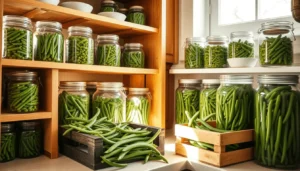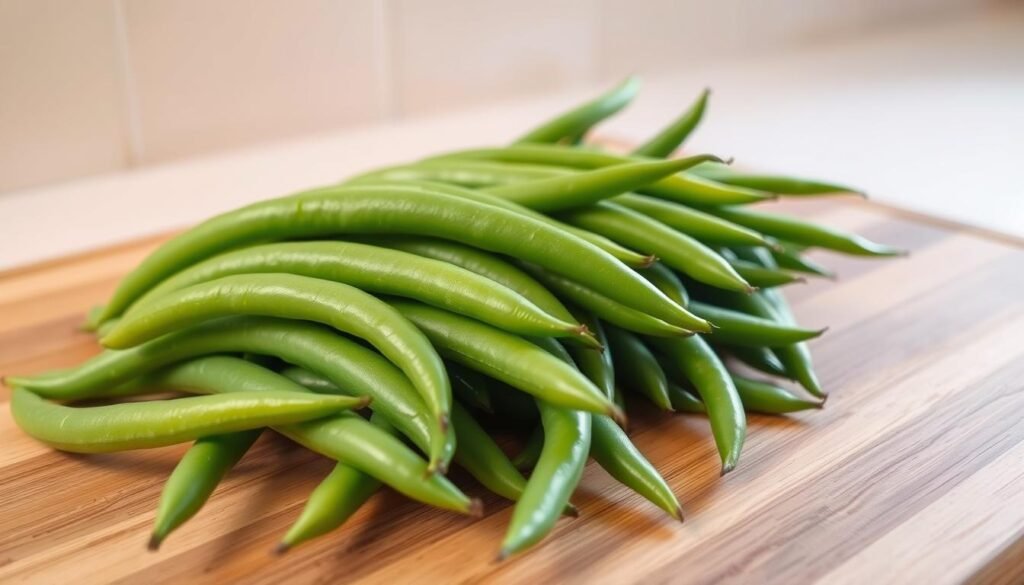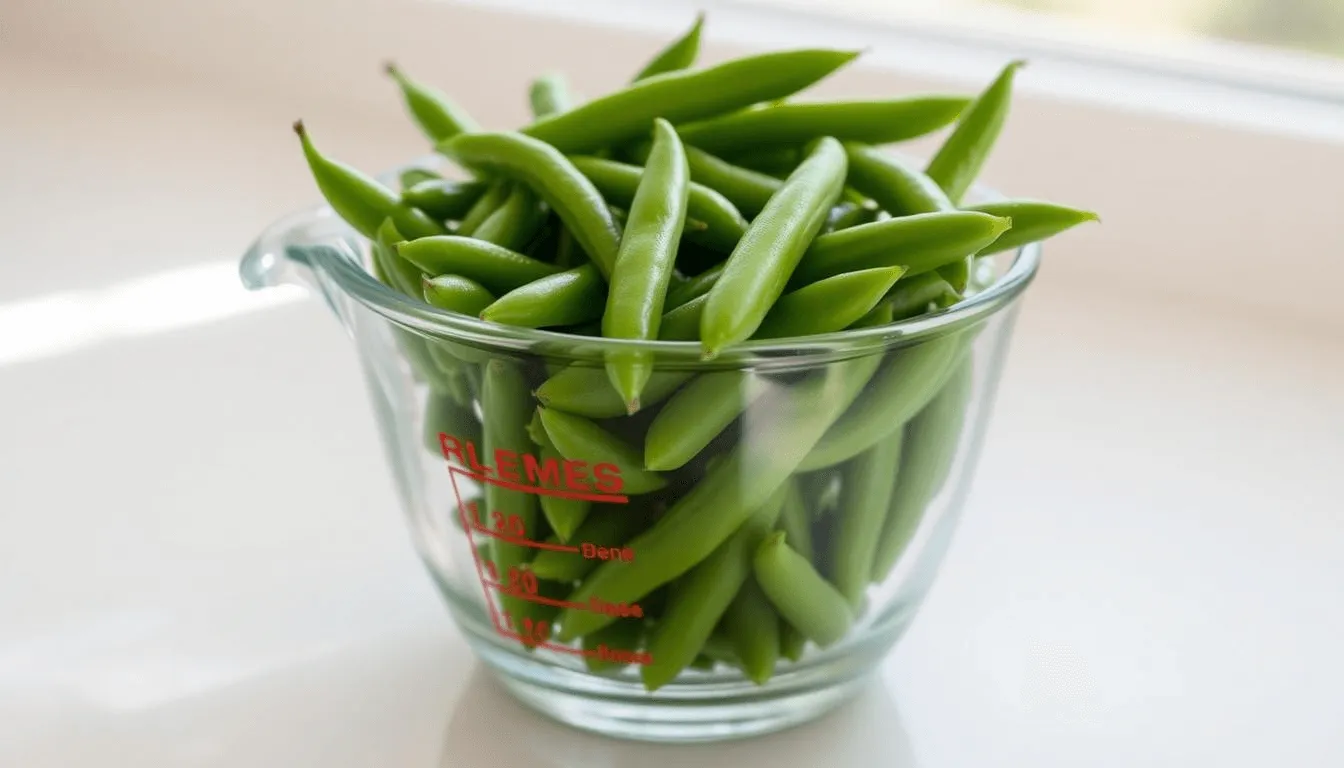When cooking, getting the measurements right is key, like with green beans. Knowing how to measure 1 cup of green beans accurately is crucial. It can greatly impact your recipe’s success. We’ll dive into the details of measuring 1 cup of green beans, showing how the amount in 1 cup can change.
This knowledge helps with green bean conversions. It ensures your dishes come out just right every time.
Key Takeaways
- Accurate measurement is essential for successful cooking.
- The amount in 1 cup can vary by type and preparation of green beans.
- Understanding measuring green beans enhances dish quality.
- Learn about green bean conversions for different recipes.
- Knowing your measurements can save time and improve efficiency in the kitchen.
Understanding Green Beans
Green beans, also known as snap beans, come from the Phaseolus vulgaris species. They are loved for their crunchy texture, making them a favorite in many dishes. Knowing about green beans helps us see their importance in both taste and health benefits. With so many varieties, finding the right type for your cooking is key.
What Are Green Beans?
Green beans are the edible pods from the common bean plant. They are long, slender, and green. People love them for their cooking versatility and health benefits. They are full of vitamins and minerals, adding value to any meal.
Different Types of Green Beans
Exploring green bean varieties reveals many types with unique tastes and textures. Here’s a quick look at some popular ones:
| Type of Green Bean | Characteristics | Best Uses |
|---|---|---|
| String Beans | Have fibrous strings along the pods | Great for steaming and sautéing |
| Snap Beans | Have a tender and crisp texture | Perfect for salads and stir-fries |
| Wax Beans | Golden in color and mild in flavor | Excellent for pickling and roasting |
Understanding the differences between these green beans helps you pick the best for your recipes. Whether you like a crunchy texture or a sweet taste, there’s a green bean for you.
Nutritional Value of Green Beans
Green beans are packed with nutrients that boost your health. They are low in calories and rich in vitamins and minerals. Let’s dive into their nutritional profile and health benefits.
Caloric Content
Green beans are perfect for those watching their calories. A ½ cup serving has about 20 calories. They’re great for snacking or adding to meals.
Vitamins and Minerals in Green Beans
Green beans are full of vitamins and minerals. Here are some key ones:
| Nutrient | Amount per ½ cup (121g) |
|---|---|
| Vitamin A | 14% of the Daily Value (DV) |
| Vitamin C | 20% of the DV |
| Vitamin K | 15% of the DV |
| Calcium | 2% of the DV |
| Iron | 4% of the DV |
Health Benefits of Green Beans
Green beans offer more than just vitamins. They can help your health in many ways:
- They improve digestion with their fiber.
- They may lower the risk of heart disease.
- They boost your immune system with antioxidants.
Measuring Green Beans: How Much is 1 Cup of Green Beans?
Getting the right amount of green beans is key for a great meal. Knowing how to switch between weight and volume helps a lot. This is true when you need to know how many cups you have or when looking at nutritional values. Let’s dive into how to measure green beans and the conversion process.
The Conversion Process
It’s important to know the difference between volume and weight when measuring green beans. A cup of green beans is about 236 grams. This can change depending on the type of green beans, like whole or chopped. Knowing these differences helps you measure green beans accurately for recipes.
How Many Green Beans Are in a Cup?
The number of green beans in a cup can change a lot. On average, 24 to 30 whole green beans fit in a cup. This helps with meal planning and portion control. But, the exact number can vary based on bean size and cut. Accurate measuring is key for the perfect dish.
| Type of Green Beans | Amount in 1 Cup | Weight (grams) |
|---|---|---|
| Whole Green Beans | 24-30 beans | 236 grams |
| Chopped Green Beans | 1 cup (packed) | 150 grams |
| Canned Green Beans (drained) | 1 cup | 120 grams |
The table shows how different preparation methods affect the amount of green beans. This knowledge helps in meal planning and staying within nutritional goals.
How to Prepare Green Beans
Preparing green beans is a fun cooking experience. These veggies can be cooked in many ways. This lets you enjoy their fresh taste and keep their health benefits. Here’s a look at different cooking methods, how to make them taste better, and some tasty green bean recipes to try.
Cooking Methods for Green Beans
There are several ways to cook green beans:
- Boiling: This method cooks the beans quickly and keeps their bright green color.
- Steaming: Steaming is great for keeping the beans’ nutrients and crunch.
- Sautéing: This method adds flavor by using olive oil and spices.
Adding Flavor to Your Green Beans
Adding flavor to green beans can make them the main attraction. Try these tasty options:
- Garlic: Adds depth and richness.
- Olive oil: A drizzle can improve texture and flavor.
- Lemon zest: Adds a refreshing touch.
Common Recipes Using Green Beans
Check out these classic green bean recipes to see their versatility:
- Sautéed Green Beans with Almonds: A tasty side dish that’s full of flavor and crunch.
- Green Bean Casserole: A holiday favorite, rich and creamy, great for gatherings.
- Simply Steamed Green Beans: A light and healthy option seasoned with a sprinkle of salt.
Buying Green Beans: What to Look For
When you’re buying green beans, you can choose from fresh, frozen, or canned. Knowing the differences helps you pick what’s best for you.
Fresh vs. Frozen vs. Canned Green Beans
Fresh green beans are loved for their bright color and crunchy feel. Look for beans that are firm and snap when bent. Frozen beans keep more nutrients and last longer, making them handy. Canned beans are easy to use, but watch out for high sodium levels.
How to Select Quality Green Beans
Choosing good green beans means looking at a few things. For fresh beans, they should be bright green and not wilted. Frozen beans should have little ice, showing they haven’t thawed and frozen again. Canned beans should have low sodium and few additives.
| Type | Appearance | Nutritional Retention | Sodium Content |
|---|---|---|---|
| Fresh Green Beans | Bright green, firm, and crisp | High | None |
| Frozen Green Beans | Similar to fresh, may appear glossy | High | None |
| Canned Green Beans | Soft texture, may appear dull | Moderate | Varies by brand |
Storage and Shelf Life of Green Beans
Keeping green beans fresh is key to enjoying their taste and health benefits. Knowing how to store them right is important. Whether you like them fresh, frozen, or canned, the right storage tips can make them last longer.
Short Term Storage Tips
For fresh green beans, the fridge is the best place. Put them in a bag that breathes to keep the right humidity and air flow. This keeps them crunchy and tasty for up to a week. Don’t wash them before storing to avoid moisture damage.
Long Term Storage Solutions
For keeping them longer, blanch and freeze green beans. This means boiling them briefly and then cooling them in ice water. After draining, pack them in airtight containers or bags. This way, they stay good for months. Canned green beans are also a good choice. Keep them in a cool, dry spot and check the expiration date for best taste and safety.

Potential Health Concerns with Green Beans
Green beans are good for many diets, but they can also cause health issues. Some people might be allergic to legumes, including green beans. Also, green beans have a lot of vitamin K, which can be a problem for those on blood-thinning meds.
Green Bean Allergy Overview
Green bean allergies are rare but can be serious. They can lead to skin rashes, stomach problems, or breathing issues. If you think you might be allergic, see a doctor right away.
Impact of Vitamin K on Blood Thinners
Vitamin K helps blood to clot. If you’re taking blood thinners like warfarin, knowing about vitamin K is key. Eating too many green beans can make these meds less effective. So, it’s important to watch what you eat.
Cooking Tips for 1 Cup of Green Beans
Preparing 1 cup of green beans should make them both healthy and tasty. The cooking method greatly affects their texture and taste. Using the right cooking tips can elevate your meal.
How to Properly Cook Green Beans
Boiling is a quick and effective way to cook green beans. Start by boiling a pot of water. Then, add your green beans and simmer for 3-4 minutes. This keeps them tender but crisp.
After boiling, quickly move the beans to an ice bath. This stops the cooking and keeps their color and flavor bright.
Understanding Portion Sizes
It’s key to consider the right portion sizes for green beans. One cup is usually enough for a side dish for one person. But, this can change based on the meal and dietary needs.
If you’re serving a big group or have different dietary needs, adjust the portions. This ensures everyone gets what they need.

Conclusion
Learning to measure 1 cup of green beans accurately is key for better cooking and nutrition. This guide has shown you the different types of green beans and their health benefits. It also covered how to prepare them.
Whether you like them fresh, frozen, or canned, knowing how to choose and cook green beans makes meals better. Techniques like sautéing and steaming keep their taste and texture great. This knowledge turns a simple side dish into a highlight of your meals.
Measuring green beans is more than just about the amount. It’s about enjoying their health perks and flavors. By adding green beans wisely to your dishes, you get to enjoy their nutritional benefits fully.
FAQ
How many grams is 1 cup of green beans?
What is the best way to store fresh green beans?
Can I freeze green beans for longer storage?
What cooking methods can I use for green beans?
Are canned green beans a good option?
What should I consider when choosing green beans at the store?
Do green beans have any health concerns?
How long should I boil green beans to keep their flavor and color?
How many calories are in 1 cup of prepared green beans?
check this recipe out for more
